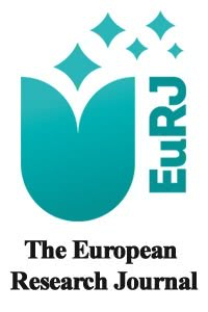Turkish speech-language therapists' perceptions and experiences of augmentative and alternative communication
Turkish speech-language therapists' perceptions and experiences of augmentative and alternative communication
Augmentative and alternative communication systems, speech and language therapy services, qualitative research speech, language,
___
- 1. American Speech-Language-Hearing Association ASHA). Roles and responsibilities of speech-language pathologists in schools [Professional Issues Statement]. 2010. Available from www.asha.org/policy/.
- 2. Beukelman DR, Pat M. Augmentative and Alternative Communication : Supporting Children and Adults with Complex Communication Needs, Brookes Publishing, 2012. ProQuest Ebook Central, http://ebookcentral.proquest.com/lib/bahcesehir-ebooks/detail.action?docID=1787388. Created from bahcesehir-ebooks on 2023-03-20 17:27:11.
- 3. Fidan K. The knowledge, experiences and recommendations of the health personnels working in the intensive care unit about augmentative and alternati̇ve communi̇cation: A mixed method study. [Unpublished MSC thesis]. Üsküdar University, Health Sciences Institure, İstanbul. 2021.
- 4. Yırtık HN, Yelek EN, Karahan Tığrak T, Bozkuş İB, Kulak Kayıkçı ME. [Development of a prototype and determination of high-tech augmentative and alternative communication system requirements for individuals in intensive care units]. Hacettepe Üniversitesi Sağlık Bilimleri Fakültesi Dergisi 2023;10:58-84. [Article in Turkish]
- 5. Iacono T, Cameron M. Australian speech-language pathologists' perceptions and experiences of augmentative and alternative communication in early childhood intervention. Augment Altern Commun 2009;25:236-49.
- 6. Hemmings B, Hill D, Davies S. Evaluating a rural-based early childhood intervention service. Spec Educ Perspect 2004;13:31-54.
- 7. Kemp C, Hayes A. Early intervention in Australia. In: Guralnick M, ed., The developmental systems approach to early intervention. Baltimore, MD: Paul H. Brookes, 2005: pp. 401-23.
- 8. American Speech-Language-Hearing Association. (2008a). Core knowledge and skills in early intervention speech language pathology practice [Knowledge and Skills]. Available from: http://www.asha.org/policy
- 9. American Speech-Language-Hearing Association. (2008b). Roles and responsibilities of speech-language pathologists in early intervention: Technical report [Technical Report]. Available from http://www.asha.org/policy
- 10. Reilly S. What constitutes evidence? In: Reilly S, Douglas J, Oates J, eds., Evidence based practice in speech pathology. London: Whurr, 2004: pp. 18-34.
- 11. Schlosser RW, Raghavendra P. Evidence-based practice in augmentative and alternative communication. Augment Altern Commun 2004;2:1-21.
- 12. Iacono T. The evidence base for augmentative and alternative communication. In: Reilly S, Douglas J, Oates J, eds., Evidence-based practice in speech pathology, London: Whurr Publishers, 2004: pp. 288-313.
- 13. Vagle MD. Crafting phenomenological research. Walnut Creek, Ca: Left Coast Press. 2014.
- 14. Thomas J, Harden A. Methods for the thematic synthesis of qualitative research in systematic reviews. BMC Med Res Methodol 2008;8:45.
- 15. Miles M, Huberman M. Data management and analysis methods. Thousand Oaks, CA: Sage Publications. 1994.
- 16. Erdoğan Ç, Demirkasımoğlu N. [Teachers’ and school administrators’ views of parent involvement in education process]. Kuram ve Uygulamada Eğitim Yönetimi 2010;16:399-431. [Article in Turkish]
- 17. Murray J, Goldbart J. Augmentative and alternative communication: a review of current issues. Pediatrics and Child Health. 2009;19(10):464-8.
- 18. Millar D, Light J, Schlosser, R. The impact of augmentative and alternative communication on the speech production of individuals with developmental disabilities: a research review. J Speech Lang Hear Res 2006;49:248-64.
- 19. McNaughton D, Rackensperger T, Benedek-Wood E, Krezman C, Williams MB, Light J. A child needs to be given a chance to succeed: parents of individuals who use AAC describe the benefits and challenges of learning AAC Technologies. Augment Altern Commun 2008;24:43-55.
- 20. Campbell PH, Milbourne S, Dugan LM, Wilcox MJ. A review of evidence on practices for teaching young children to use assistive technology devices. Topics Early Child Spec Educ 2006;26:3-13.
- 21. Hodgdon LA. Visual strategies for improving communication: Practical supports for school and communication. Michigan: Quirk Roberts Publishing. 2000.
- 22. Johnston S, Nelson C, Evans J, Palazolo K. The use of visual supports in teaching young children with Autism Spectrum Disorder to initiate interactions. Augment Altern Commun 2003;19:86-103.
- 23. Mirenda P, Brown K. A picture is worth a thousand words: using visual supports for augmented input with individuals with autism. In: Mirenda P, Iacono T. eds., Autism and AAC. Baltimore: Paul H. Brookes, 2008: pp. 303-32.
- 24. Iacono T. Language intervention in early childhood. Int J Disabil Dev Educ 1999;46:383-420.
- 25. Snell ME. Using dynamic assessment with learners who communicate nonsymbolically. Augment Altern Commun 2002;18:163-76.
- 26. Beamish W, Bryer, F. Practitioners and parents have their say about best practice: Early intervention in Queensland. Int J Disabil Dev Educ 1999;46:261-78.
- 27. Kent Walsh J, Light J. General education teachers’ experiences with inclusion of students who use augmentative and alternative communication. Augment Altern Commun 2003;19:104-24.
- 28. Scope. More than my child’s disability: A study of family-centered practices and family experiences of Scope early childhood intervention services and supports. (Research Project). Melbourne: Scope (Vic). 2004.
- 29. Smith MM, Connolly I. Roles of aided communication: perspectives of adults who use AAC. Disabil Rehabil Assist Technol 2008;3:260-73.
- ISSN: 2149-3189
- Yayın Aralığı: 6
- Başlangıç: 2015
- Yayıncı: Prusa Medikal Yayıncılık Limited Şirketi
Anıl ERTURK, Gulay GOKCE, Nergis KENDER ERTURK
Zeynep KARAGÜN, Deniz ÇELİK, Mehmet Sinan AYDIN, İbrahim GÜNDOĞMUŞ, Yusuf Tuğrul ŞİPİT
İbrahim ACIR, Hacı Ali ERDOĞAN, Hülya OLGUN YAZAR, Melis SUSKUN, Vildan YAYLA
Long-term outcomes of COVID-19 infection in patients with solid tumors
Oktay ÜNSAL, Ozan YAZICI, Ömer Faruk ÖZKAN, Gözde SAVAŞ, Nuriye YILDIRIM ÖZDEMİR, Aytuğ ÜNER, Nazan GÜNEL, Ahmet ÖZET
Vildan GÜRSOY, Suna AVCI, Selime ERMURAT, Ali EROL, Melike YAZICI
Prognostic value of the leuko-glycemic index in coronary chronic total occlusion patients
Tezcan PEKER, Mehmet ÖZBEK, Bedrettin BOYRAZ, Selen Filiz ASLAN, Muhammed DEMİR, Burhan ASLAN
The severity of hyponatremia worsens the outcome in pediatric intensive care patients
